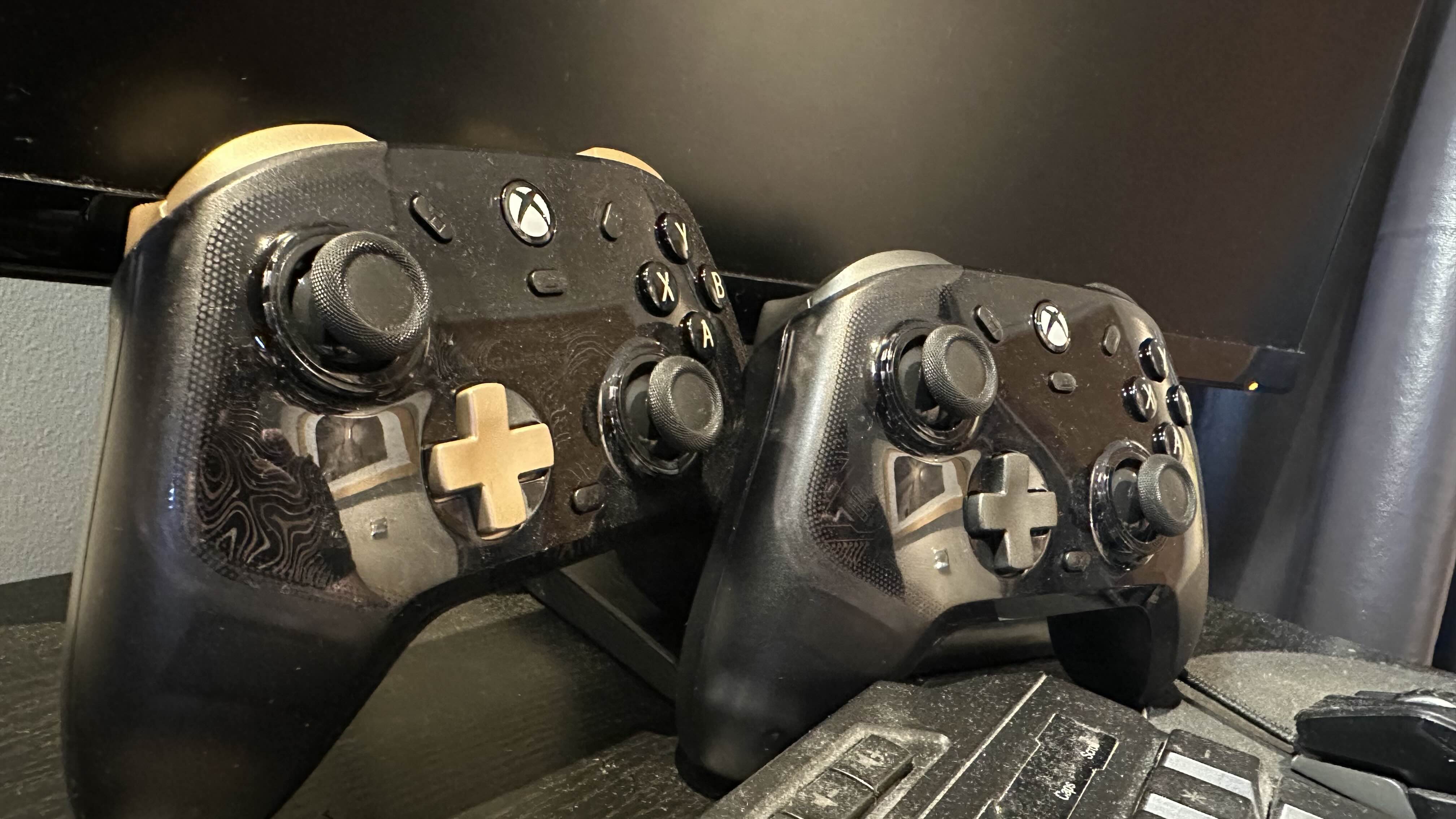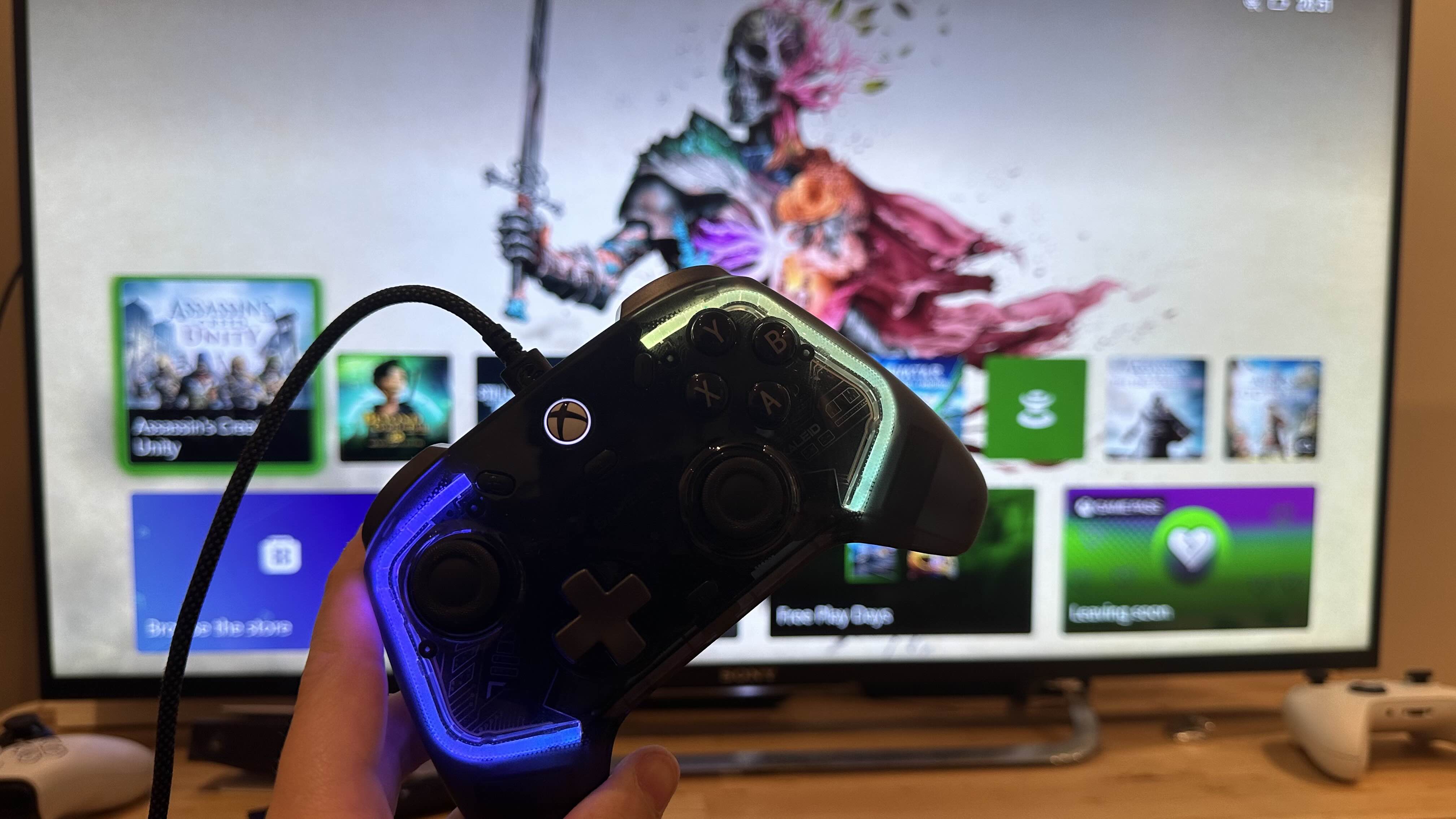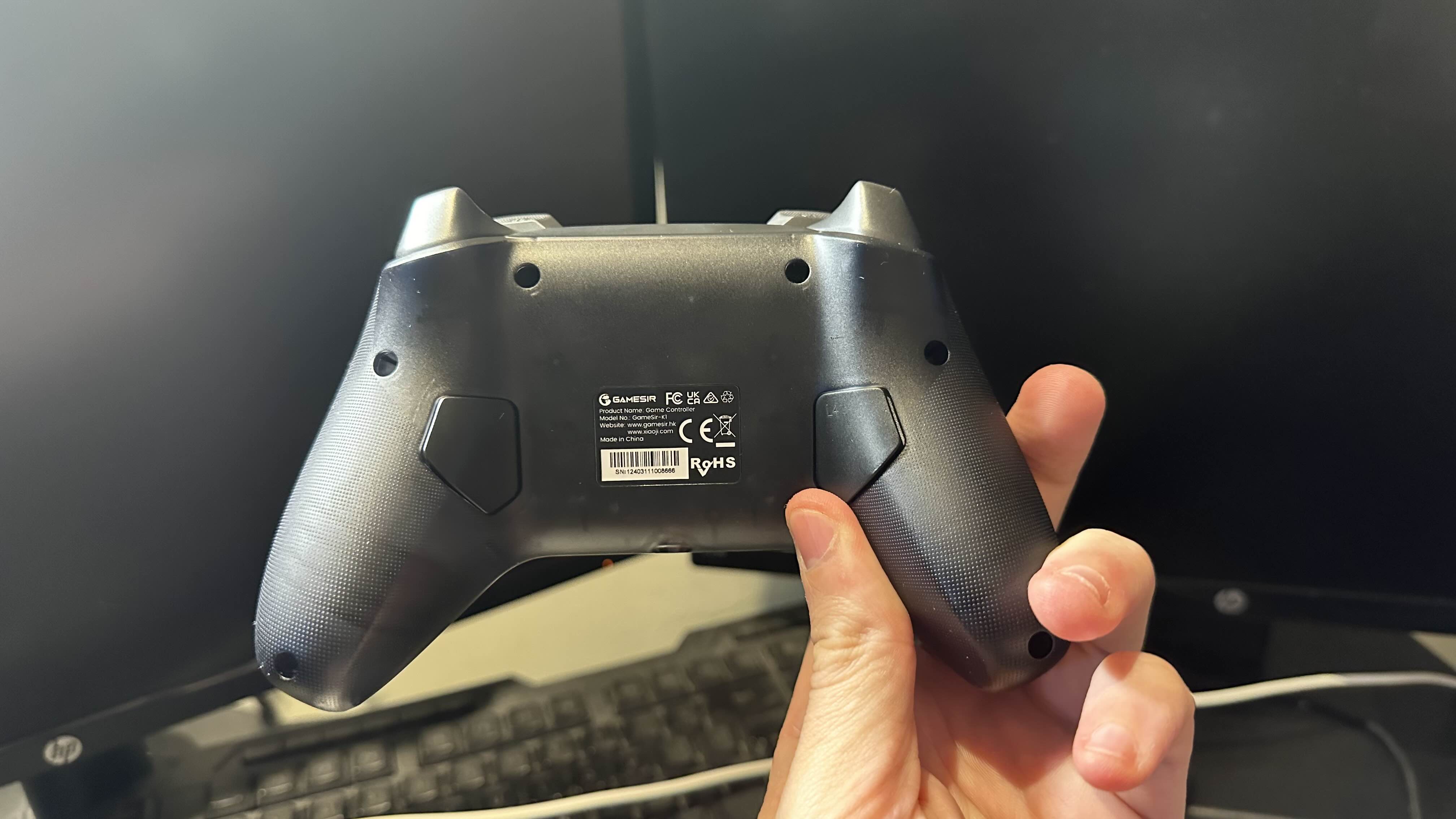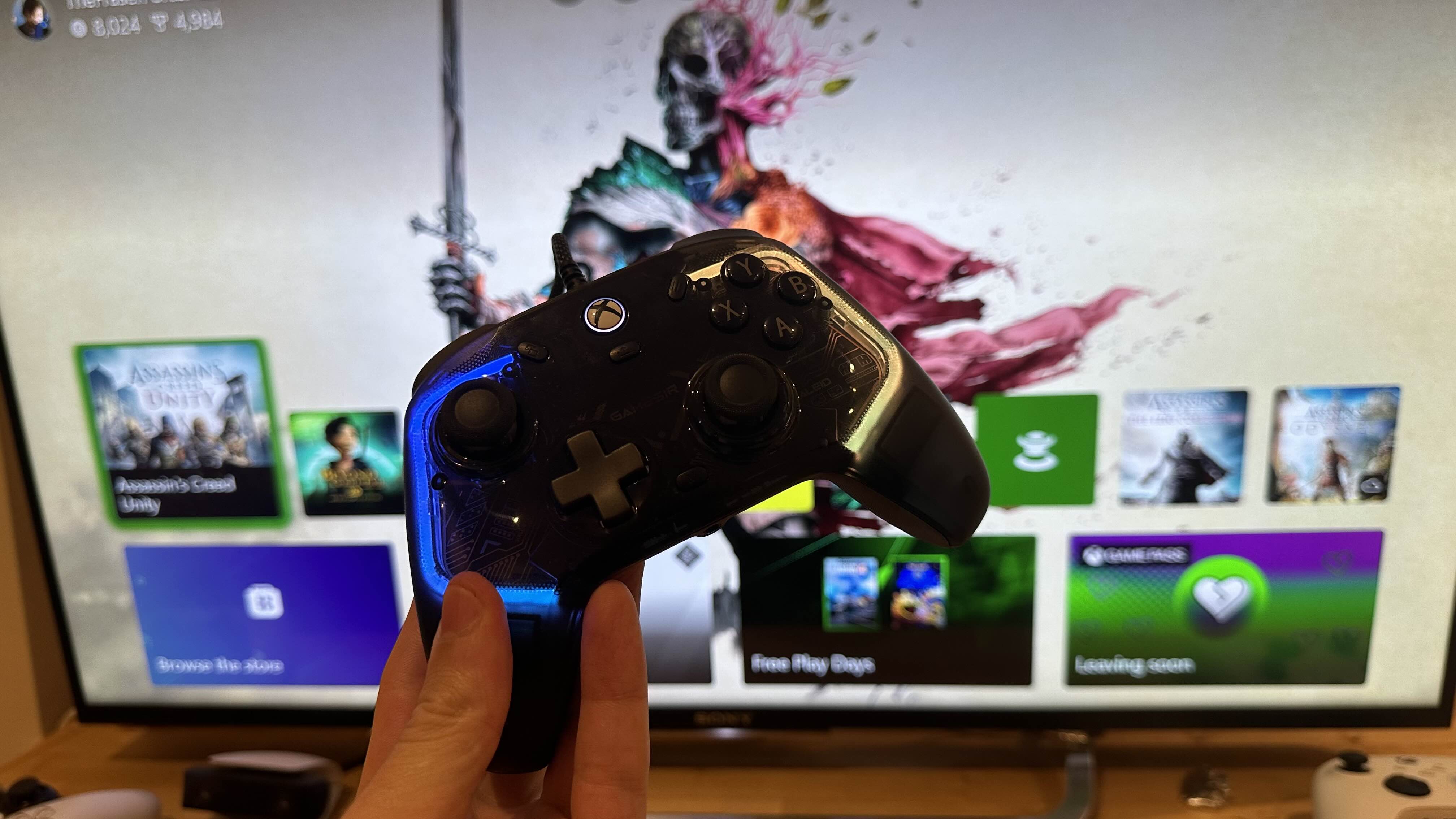GamesRadar+ Verdict
The GameSir Kaleid for Xbox is incredible value for money if you want a controller with all the necessary pro features but without hurting your bank account.
Pros
- +
Nostalgic transparent design
- +
Back buttons are ergonomically placed and satisfying to use
- +
Hall Sensor Sticks
- +
Incredible value for money
Cons
- -
Wired only
- -
Feels too light in the hands
Why you can trust GamesRadar+
Do you ever find yourself wanting pro controller features when playing games, but don’t want to pay the crazy prices that some PC and Xbox controllers have attached to them? I know I do. That’s the exact scenario that the GameSir Kaleid (and the GameSir Kaleid Flux) For Xbox is trying to solve. They’re packed full of features at a reasonable entry price, but does that lower price mean less quality?
The best Xbox Series X controllers don’t tend to suffer from stick drift as easily as those made by Nintendo and Sony, but when we reviewed the original GameSir T4 Kaleid for PC and Switch, we were big fans of how affordable it made Hall Sensor technology. Now, making its way to Xbox, the Kaleid will bring anti-drift thumbsticks to a market where it’s usually locked behind a higher paywall.
Sitting at just $49/£59 for the regular version or $46/£56 for the ‘Flux’ version of the controller, it’s certainly an intriguing offer. Why pay upwards of $100 to get some extra buttons and fancy sticks when this can do it at half that price and with a really unique look too?
Design

The first thing you notice with the GameSir Kaleid For Xbox is the transparent design on the casing, which harkens back to the days of old when both controllers and consoles would sometimes come in transparent variations. I have fond memories of sitting cross-legged on my bedroom floor playing Ratchet and Clank 3 on my PlayStation 2 with a transparent purple Dualshock 2 controller, so picking up this controller for the first time filled me with a wave of nostalgia. It genuinely brought me so much delight seeing a modern design with such a retro look - the fact that the PS2 generation can be considered ‘retro’ also scares me too, don’t worry.
The standard Kaleid controller is accented by a silver d-pad and bumpers/triggers, while the Flux model is trimmed with golden alternatives. This is one of only a couple of differences between the two controllers, although the Flux version is marginally cheaper. What are those other differences I hear you ask? Well, the standard version of the controller features tactile micro-switches for its buttons and d-pad, while the Flux version features membrane ones. Essentially, the standard controller will feel more ‘clicky’ while the Flux will feel more ‘cushiony’; that’s really all there is to it when it comes to making these sister controllers stand apart from each other. Since that’s the case and I’ve been testing out both versions, I’ll refer to both controllers as one device from here on out.
I found the additional back buttons a revelation that opened up a whole new way to play each game and really elevated my playtime with them.
On the rear of the controller, you’ll find two additional buttons placed exactly where your middle fingers lie when holding the controller, this allows easy access to extra buttons during those high-stress gaming environments. This is the type of feature you’d expect one of the best PC controllers to have and it’s good to see them here and in such a comfortable location.
Underneath the hood, which you can see because of the aforementioned transparent look, you’ll find Hall Effect sensors on the asymmetrical sticks. In short, these use magnetic sensors and don’t involve any physical components that wear down over time. Most controllers on the market use potentiometer mechanisms which do suffer from wear and tear, and often catch stick drift over time.
This same technology is used in the triggers which, according to GameSir, provides gamers with higher accuracy and smoothness when operating the controller; this is cited by GameSir as having an accuracy of 0.1mm. Alongside this they site the face buttons on the controller as having a lifespan of 5 million clicks - despite how large that number is I can’t help but worry when playing just how many clicks that is in practical terms - and an actuation distance of 0.6mm.
Features

Sadly, there is no wireless option for either controller. This is standard for third-party Xbox controllers as Xbox stipulates in their licensing agreements that they can’t use wireless frequencies to connect. Because of this, the GameSir Kaleid For Xbox features a USB-C port at the top of the device which connects to your Xbox via a 3m USB-A connector. It’s a small annoyance but one that could make or break it for people. Honestly, you do forget that it’s attached with a cable after a while but I personally do prefer being cordless.
Despite being targeted at Xbox players, the Kaleid can also be used on PC. This once again connects via the provided USB cable and works seamlessly with the companion software which allows you to have a little bit more customization. As this is aimed at Xbox I didn’t spend too much time in this software. All the features you need work straight out of the box with your Xbox console. This is achieved via the addition of an ‘M’ button which allows you to program the rear buttons to whatever combination you want them to be. You can also alter the RGB that highlights the gamepad from within.
Yes, of course, there is RGB. Seemingly any pro controller or gaming tech needs to light up your room like the Blackpool illuminations and it’s no exception here. While that might seem harsh, personally I’m not the biggest fan of RGB. While I appreciate it on some devices, others I just can’t get behind. I didn’t find it too distracting here but I did find myself turning the intensity down so my hands weren’t flashing like a Christmas tree. I think if you like RGB you’ll love this, if you don’t then there are ways to get around it and turn it off, so really it’s not too much of an issue.
Performance

For such a cheap price I was expecting corners to be cut on how it actually feels to use and the mirage of the ‘pro’ controller tag to be broken. To my surprise, this controller feels just as pro as the advertisement. Having tested the controller on a wide variety of games including Avatar: Frontiers of Pandora, Forza Horizon 5, Starfield, and Assassin’s Creed Valhalla, I found the additional back buttons a revelation that opened up a whole new way to play each game and really elevated my playtime with them. After using the feature for a couple of weeks for my everyday gaming I reverted to my stock controller to see if I noticed a difference, it genuinely threw me off for the longest time not having access to Gamesir’s back buttons. The big console makers really need to consider adding them to standard controllers from here on out.
Having an easy way to enter Eagle Vision in Assassin’s Creed Valhalla or call my mount of Avatar: Frontiers of Pandora made things almost too easy and incredibly helpful. In those high-stress and fast-paced environments, they allowed me to stay relaxed and not worry about what buttons I was pressing and when. I often found myself mapping the rear buttons to the command of pressing each joystick in, this meant in FPS games I had easy access to melee and sprint without having to press the sticks in.
Speaking of the sticks, they felt precise throughout my use across the previously mentioned games, particularly in the first-person shooter titles like Avatar: Frontiers of Pandora and Starfield. The sticks felt snappy and I didn’t have to tweak too many in-game settings to get them to a sensitivity I was comfortable with, they simply worked and worked well. The texture of the sticks also was a pleasant surprise, they reminded me of the Dualshock 4 sticks in terms of shape but felt much more akin to the DualSense Core or Xbox controller due to their higher tension. I never found them uncomfortable to use even in longer gaming sessions.

The Hall Sensors featured on both the sticks and the triggers provided peace of mind that I was getting as much accuracy as possible and that the controller wouldn’t fail me. However, I never really found myself calling on the Hair Triggers that often. I tested them a couple of times within Avatar and Starfield but preferred them off. Perhaps I would have gotten more use out of them if I were a more competitive multiplayer-orientated gamer? But for me, they just didn’t click (if this is a pun, then I fully intended it. If not then please ignore these brackets).
Using the helpful ‘M’ button was simple and effective - press the prompt and then click the corresponding button you’d like to remap. I often found myself changing the mapping of buttons mid-session so that I could optimize the controller to my preferred playstyle depending on the game I was playing. I would highly recommend keeping hold of the manual that comes with the controller as this will explain all the many ways you can reprogram it.
Despite the whole controller feeling premium and fitting the ‘pro’ controller tag, I did find the GameSir Kaleid For Xbox at times to feel more like a toy when compared to the stock Xbox controller. I think this is in large part due to the light weight of only 219g in contrast to the stock controller's 287g, it’s not too big a difference but one I noticed immediately. It wasn’t a deal breaker but I have to be honest and say I preferred the heavier weight as it makes for better build quality.
Should you buy the GameSir Kaleid / Kaleid Flux

Similar to GameSir’s efforts with their Switch controller, the T4 Kaleid, the Xbox counterpart is an impressive effort and one that deserves a lot of attention for bringing gamers everything they need to feel like a pro at a very reasonable and welcoming price.
Key features such as Hall Effect joysticks should be standard across the gaming space, which is more than you can say for more expensive alternatives such as the Xbox Elite Series 2 controller.
In our review of the original T4 Kaleid, we said “I wish it had Xbox and PlayStation support because budget buyers would be lucky to have this on those platforms” and as luck would have it, it’s now an option on one of those platforms. I really struggle to find issues with this controller outside of some personal preferences when it comes to the weight, the lack of wireless connectivity (which is outside of GameSir’s control), and the RGB.
This controller is built to last and I have full faith that it will please anyone looking for one of the best Xbox controllers to level up their gameplay sessions and feel like a gaming pro without breaking the bank.
How we tested the GameSir Kaleid / Kaleid Flux
I spent 2 weeks using the controller as my main controller when playing on Xbox and PC. I put it through its paces while playing multiple games listed throughout this review (Avatar: Frontiers of Pandora, Forza Horizon 5, Starfield, and Assassins Creed Valhalla) and used it for roughly 25 hours of gameplay before writing the review.
For a full rundown of our testing methods, enjoy a gander at our hardware policy.
Take a look at the best PS5 controllers for a list of anti-stick drift options on that platform. Alternatively, check out the best Nintendo Switch controllers, or the best joysticks.
For as long as I can remember, I've had a fascination with video games and technology. From a young age, I was always reading up on the latest tech and begging my parents to buy it for me - now I have my own job and make my own money, I realize why they often had to say no to my requests. For that reason, I love trying to find the best value gear so I can recommend it when asked. I studied Journalism at Edinburgh Napier University and throughout my time there gaming was one of my main focuses. Alongside Duncan Robertson, I was the co-host of NerdCulture, a weekly gaming and nerdy news radio show. My time as Studio Manager for the uni radio station meant tinkering with a lot of technology to ensure each broadcast worked smoothly. Elsewhere, you can find me discussing professional wrestling as Cultaholic's Community and Social Media Manager, and you'll also see me on the occasional Twitch stream.




